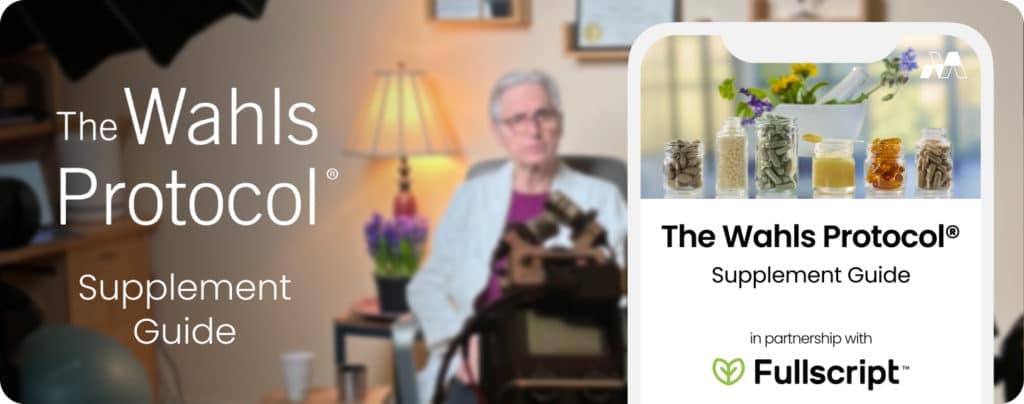Written by MasterHealth Staff
Jump To Section
One of the biggest questions we hear is: How am I going to consume 9 cups of vegetables every day on the Wahls Diet™ as part of the Dr. Terry Wahls Protocol®?
We’ve done the research – pulling together as many answers as we could from The Wahls Diet™ and The Wahls Protocol®, tips offered by people in the MasterHealth community for The Wahls Protocol®, and other resources – so you don’t have to look any further.
The first two levels of The Wahls Protocol® – Wahls Diet™ and Wahls Paleo™ – call for the addition of 6-9 cups of vegetables divided evenly into leafy greens, sulfur-rich veggies, and deeply colored veggies and fruits.
Each of these veggie groups contain a unique set of nutrients critical for health.
The struggle
Squeezing 6-9 cups of vegetables into your diet each day might seem impossible, between preparing the meals and actually eating them. The good news is that there are some quick and easy ways that you can sneak in an extra cup here and there into your day.
Lucky little…
If you’re more petit, it’s okay for you to consume closer to 6 cups each day. But if you have a larger build, you should aim closer to 9 cups of vegetables to fill you up.
Leafy greens are included in The Wahls Protocol® and Dr. Terry Wahls Diet™ because they’re loaded with prebiotic fiber, which is food for your beneficial probiotic bacteria.
Leafy greens also contain antioxidant vitamins A, C, and E, as well as vitamins B and K which are especially important for nerve and brain health.
Dr. Terry Wahls suggests consuming 3 cups of cooked, or 6 cups of raw leafy greens each day to get your daily dose. This is only a discrepancy with leafy greens because they contain more water than other veggie groups, which evaporates out during the cooking process.
Examples of Leafy Green Vegetables:
- Swiss chard
- Cilantro
- Parsley
- Beet greens
- Romaine
- Escarole
- Wheatgrass
- Dandelion greens
- Endive
- Spinach
- Red/green lettuce (except iceberg lettuce)
- Radicchio
Pro tip: To reinvigorate wilted greens, cut a small section off the tip of the stem and place the greens in a vase or cup of water (like you would flowers) and store in the fridge, changing water daily.

Sulfur-rich vegetables are included in The Wahls Protocol® because they contain amino acids necessary for maintaining healthy DNA. Sulfur-rich veggies also contain glutathione, an important antioxidant essential for healthy functioning mitochondria – the energy makers of the body.
Examples of sulfur-rich vegetables:
- Asparagus
- Broccoli
- Brussels sprouts
- Cabbage
- Cauliflower
- Turnips
- Garlic
- Kohlrabi
- Chives
- Onions
- Scallions
- Shallots
- Mushroom
- Leeks

Some greens qualify as both a leafy green and sulfur-rich veggie.
When consuming these foods, consider each cup one half of a serving of leafy greens and one half sulfur-rich veggie.
For example, if you eat six cups of sulfur-rich leafy greens, that counts as your 3 cups of leafy greens and 3 cups of sulfur-rich food.
However, diversity is best! You’re not doing yourself any favors by eating only arugula to get your leafy greens and sulfur-rich veggies in.
Dr. Terry Wahls, who developed The Wahls Protocol® encourages diversity when eating your 9 cups of vegetables to optimize your nutrition and maintain the resilience of your gut microbiome – the beneficial bacteria you want to thrive in your body.
Examples of sulfur-rich leafy greens:
- Mustard greens
- Watercress
- Turnip greens
- Tatsoi
- Arugula
- Bok choy
- Collard greens
- Kale
The last veggie group in The Wahls Protocol® is deeply colored veggies and fruits.
Deeply colored veggies contain antioxidants known as polyphenols which improve heart and circulatory health and reduce inflammation. The deeper the color when cut in half, the higher their antioxidant content!

Examples of deeply colored vegetables and fruits:
Greens
- Artichoke
- Green beans & peas
- Avocado
- Okra
- Green kiwi
- Green Grapes
- Honeydew melon
- Limes
- Green pepper
- Celery
- Zucchini
Red
- Beets
- Rhubarb
- Cranberries
- Cherries
- Grapefruit
- Raspberries
- Blood orange
- Red grapes
- Red peppers
- Pomegranate
- Watermelon
- Tomatoes
Purple/Black
- Blackberries
- Blueberries
- Adonai berries
- Elderberry
- Black or purple grapes
- Plums
- Prunes
- Purple raisins
- Purple carrots
- Black olives
- Dates
- Purple figs
Orange
- Orange carrots
- Oranges
- Nectarines
- Golden kiwi
- Lemon
- Papaya
- Yellow peppers
- Pineapple
- Pumpkin
- Squash
- Sweet potato/yam
- Golden raisins

Want some new ideas to curb your food cravings?
Meal prep:
Try setting aside one or two days each week to prepare your 9 cups of vegetables for the week ahead. You can save time by freezing chopped and/or steamed veggies in advance.
Make smoothie packs:
Make packs of the veggies and fruit for the next day’s smoothie so that all you have to do is blend and sip in the morning.

Smoothies are an easy way to quickly and deliciously add 1 or more servings of each group of veggies to your day. After a smoothie, you’ll be well on your way to getting 9 cups of vegetables in!
They can be loaded up with leafy greens, sulfur-rich veggies and deeply colored fruits and still be delicious.
If you’re short on time for a morning meal, make a bigger smoothie by adding more of each ingredient and double up on your protein powder.
- ½ cup leafy greens
- ½ cup red cabbage or frozen cauliflower (sulfur) or frozen zucchini (color)
- ½-1 cup of frozen berries
- 2 cups of liquid of choice (i.e. plant-based milk, water, steeped herbal tea)
- 1 tbsp of fat (i.e. coconut oil, nut butter, MCT oil, flaxseed oil, extra virgin olive oil) or half of an avocado
- Flavorings (i.e. spices, herbs, food grade essential oils and extracts, whole lime)
- Plant-based protein powder (Optional)
Pro tip: Chopped red cabbage can last in the fridge for several weeks, making it a great staple to have in the kitchen. When pre-chopped, it can be quickly added to smoothies, salads, or soups.
- If you can eat eggs or soy, this will be easier for you. Cook your eggs the way you like for your protein. If you can’t eat eggs, consider other protein sources like different meats, organic tofu, tempeh, beans & legumes, or leftovers.
- Sauté or add to an omelet/tofu scramble: 2 cups of fresh (1 cup sautéed) leafy greens or sulfur-rich leafy green (i.e. spinach, Swiss chard, kale) with 1 cup of sulfur veggies (i.e. onion, garlic or mushrooms).
- Add 1 cup of colored veggies. This might look like:
- ½ avocado on gluten-free toast and/or
- Tomatoes or colored peppers added to omelet or sautéed as a side
First: Save more time by pre-chopping your veggies and cooking a little extra for leftovers! Some veggies have a longer fridge-life and can become great staples to have in your fridge (even pre-chopped), like red cabbage, sweet potato, beets, carrots and onion to make it easier to get your 9 cups of vegetables in.

Red/purple cabbage is a superstar, since it can be quickly added to smoothies, salads, or soups. Although it has a reputation as a sulfur-rich veggie, it also contains polyphenolic antioxidants which tend to be more common within deeply colored veggies (hint: the deep purple color).
Sautéing onions and garlic is an easy way to add an extra cup of sulfur-rich veggies into your meals. Other veggies and fruits can also be easily added to salads to add color, like tomatoes, carrots, bell peppers, or add sulfur, like mushrooms, radishes, onions, and asparagus.
Vegetables can also be stuffed into your protein or substituted for different grains in the following ways:
- Chicken stuffed with a leafy green and garlic
- Beef or pork tenderloin with slits cut into it and garlic cloves stuffed into the slits
- Zucchini lasagna (instead of lasagna pasta) with various veggies & ground protein
- Hearty vegetable soup with your choice of protein
- Spaghetti squash (instead of spaghetti pasta) with ground protein & other veggies
- Shredded cauliflower instead of rice
If you don’t have leftovers, use the following template as a guide for a quick and easy lunch:
- Protein of choice (i.e. chicken, beef, organ meats, fish, tofu, tempeh, beans, etc.)
- 1 cup sautéed leafy greens (2 cups raw)
- 1 cup sulfur and/or sulfur-rich leafy greens (mushroom + onion, or kale + Brussels sprouts)
- 1 cup colored veggie (purple carrot, tomato, zucchini, etc.) sautéed or added to a salad
- Add your favorite spices and serve with a bed of rice, quinoa, or grated cauliflower for extra sulfur.
- Protein of choice (i.e. chicken, beef, organ meats, fish, tofu, tempeh, beans, etc.)
- 1 cup sautéed sulfur (i.e. mushroom, onion and/or Brussels sprouts) with ½ cup colored veggie (i,e. zucchini, carrots, tomato, peppers, sweet potato)
- 2 cups leafy greens or sulfur-rich leafy greens salad with ½ cup fresh colored veggie (i.e. tomatoes, colored peppers, black olives, carrots and/or raisins)
- Add your favorite spices and serve with a bed of rice, quinoa, or cauliflower.
- ½ cup of colored fruits for dessert

Roasting spaghetti squash:
- 1 spaghetti squash
- 2 tbsp extra virgin olive oil
- Salt and freshly ground black pepper
Preparation instructions:
- Preheat the oven to 400°F.
- Slice the spaghetti squash in half lengthwise and scoop out the seeds and ribbing. Drizzle the inside of the squash with olive oil and sprinkle with salt and pepper.
- Place the spaghetti squash, cut side down, on a baking sheet and use a fork to poke holes in the shell. Roast for 30 to 40 minutes or until lightly browned on the outside, fork tender, but still a little bit firm. The time will vary depending on the size of your squash.
- When ready, remove squash from the oven and flip the squash so that it’s cut side up. When cool to the touch, use a fork to scrape and fluff the strands from the sides of the squash. Transport the “noodles” into a separate dish or onto plates for serving with your favorite pesto or spaghetti sauce.
- 2 cups sliced almonds
- ⅓ cup freshly squeezed lemon juice (from 2 to 4 lemons)
- Kosher salt
- 1½ cups extra-virgin olive oil
- 4 cloves garlic, crushed with the flat side of a knife, peeled and left whole
- 1 ½ – 2 cups washed and dried kale leaves, thick stems removed
- Lemon zest
- 1 ½ cup nutritional yeast (optional)
Preparation instructions:
- In a toaster oven, conventional oven, or skillet toast almonds until lightly browned and fragrant. Or, purchase pre-toasted sliced almonds to save time.
- In a small bowl, mix together the lemon juice and 1 teaspoon of salt, whisking in the olive oil.
- Add garlic cloves, set aside to rest.
- Grab one bunch of kale and hold it tightly, slicing roughly ¼ inch thick strips. Add kale to a large bowl, sprinkling with almonds and nutritional yeast. When ready to serve, remove the garlic cloves from the dressing and pour half of the dressing over the kale, adding lemon zest, salt and pepper to taste
- 1 large bundle of fresh curly parsley, chopped
- ⅓ cup diced red onion
- 1 large red bell pepper or cherry tomatoes
- 3 tbsp lemon juice (1 medium lemon, roughly)
- 2 tbsp extra virgin olive oil
- 1 pinch sea salt and freshly cracked black pepper
- 3 tbsp hulled hemp hearts or sunflower seeds
Preparation instructions:
- Combine all ingredients, and add more lemon, oil, salt or pepper as needed.














